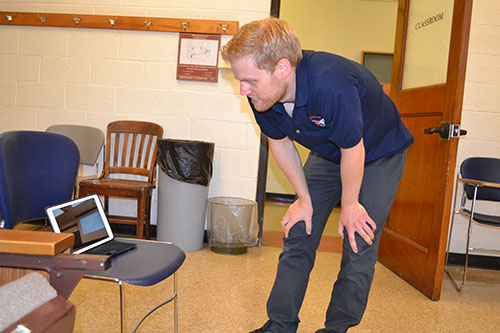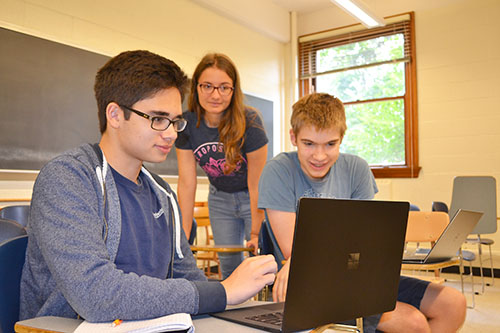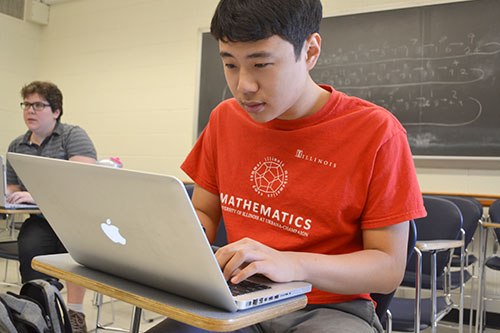The Illinois Geometry Lab Partners with Uni High to Expose Students to Research
June 28, 2019

Uni High students Sparsh Singh, Grant Hoey, and Matthew Tang at work doing combinatorics research.
For the second summer in a row, the Illinois Geometry Lab (IGL) in the Department of Mathematics partnered with University Laboratory High School (Uni High) to provide research projects for some of the school’s students. For four weeks from June 3rd through June 28th, 15 high schoolers visited Altgeld Hall to conduct math research, mentored by Illinois Math graduate students. The idea was to expose the younger students to math not traditionally taught in school and also to give them a taste of what math research is like. In addition, the younger students experienced another aspect of academia: they prepared presentations then presented their research at a final event on Thursday, June 27th.

IGL Director and Math Associate Professor Philipp Hieronymi and Uni High teacher Ioana Boca.

Professor Hieronymi gives a little introductory speech before the students present their work at the end-of-the-project presentation event.
IGL Director Philipp Hieronymi and Uni High teacher Ioana Boca shed some light on how the IGL/Uni High partnership came about. The school had received a gift from Uni High alumnus, David Frankel, the CEO of ZipDX LLC, to support collaboration between the school and campus units at Illinois. “We have some students at Uni High who can work way beyond [what] we offer them at school in class,” Boca admits, explaining why the partnership was initiated. And because some gifted Uni High students had previously worked with IGL, she was familiar with the lab’s work, so she approached them.
The idea was to come up with a research opportunity for a larger, more diverse group of students academically. So they created a research opportunity between IGL and Uni High, which began in the summer of 2018, ran again the summer of 2019, and will possibly continue in the future, depending on the availability of funding.
To recruit Uni High students last year, Boca had approached nine of the very top students who had been taking higher-level university math courses. However, to recruit this year’s participants, she opened up the application process to juniors, sophomores, and even some freshmen, inviting them to submit an application which included info about their interests and backgrounds.
Around February, IGL advertised the mentoring opportunity to Math grad students, who were excited about taking some time in the summer to mentor a group of bright young high school students and, thanks to Frankel’s contribution, also receive a stipend for their efforts.
According to Hieronymi, one of the challenges was creating research projects that high school students could do. “Even for faculty in the math department,” he explains, “it's hard to run undergrad research projects because there's such a big learning curve. It's tough to come up with good integrated research.” He calls fact that the graduate students were able to do this on a larger scale, “quite impressive,” adding: “I'm extremely impressed by them, by the work that the graduate students have done.”

Aniket Gargya and Catherine Guo present their research on vizualizing mathematics.

Philipp Hieronymi chats with David Frankel via Skype.
To assign the students to mentors, Boca, Hieronymi, and the grad students met and assigned students to projects based on students’ interests and some of the math courses they’d taken. The five different research teams were each comprised of a Math grad student, the team leader, along with three high schoolers. Teams met three times a week for three hours each to investigate five different topics in research mathematics.
An important component of the program, in addition to doing the research itself, was preparing talks then presenting the research to many of the key players, including parents, at an end-of-the-program session on Thursday, June 27th. In fact, the donor, David Frankel, who was in France at the time, Skyped in for the final presentation. “We let him know,” says Boca, “and he said he would be delighted to join even though in France it will be midnight!”
The five topics researched covered a wide spectrum and, in some cases, were somewhat related to the grad students’ research. For instance, one project, Visualizing Mathematics and Its Applications, was led by sixth year PhD student Vanessa Rivera-Quiñones, who defended in April and will graduate this summer. Her area of study is Mathematical Biology, which translates real-life problems in the life sciences into mathematical structures or models to describe how systems behave over time and to provide insight to problems. She and her team explored using tools from evolutionary biology and game theory to study cooperation. In her own work, she studies how competition among species can lead to different diverse populations which can be studied also using an evolutionary framework.
Rivera-Quiñones got involved with the Uni High mentoring program because she had previously been an IGL mentor and had really enjoyed the experience. When she heard of this program, she decided that she wanted to use concepts from her line of research to work on a project with the students:
“I wanted them to see how math can be used in many areas, including but not limited to biology.”

Vannessa Rivera Quiñones, mentor of the Visualizing Mathematics and its Applications project, proudly hands certificates to two of her project members: Aniket Gargya and Catherine Guo. The third, Peter Zhang, was unable to attend the event.
Rivera-Quiñones reports that one of the benefits of this project is that it has a strong programming component: her students have been learning how to implement an algorithm in Python. “This is a useful skill that they can apply to different projects in the future,” she explains. Also, she says they’ll gain presentation skills. “For me, a big part of doing research is also communicating it to a broader audience,” she acknowledges. “I hope by the end of the project, my team can gain experience in showcasing the big ideas behind their work to the public.”
Leading another research group looking into Chip-Firing Games on Graphs was Dana Neidinger, who is studying graph and number theory and just finished her third year in Math’s PhD program. Neidinger calls their project “pure math research.” It involves looking at cycles arising from a certain type of game on complete graphs. Because she has a background in graph theory research, this is a topic that Neidinger has been interested in; however, it’s not immediately related to her thesis research.
Neidinger got involved with the program because she enjoys “working with younger students and introducing them to what mathematical research is actually like.” Having participated in the program last summer, she admits, “The students exceeded my expectations in their mathematical maturity and ability to work on hard problems. However, I believe that every high school student, not just exceptional students like these, can learn to approach mathematics in a creative, exploratory manner.”

Dana Neidinger (center, and her group of Uni High students, Jonathan Lau, Pomona Carrington-Hoekstra, and Kevin Li, discuss a problem related to their research.
According to Neidinger, the project in particular is focused on developing students' abilities to generate examples, find patterns, make conjectures based on those patterns, and rigorously prove their conjectures. “Many students have a natural mathematical curiosity that is often not fostered in traditional school math, and by participating in a project such as this, these students can ask and rigorously answer questions that are of interest to them. These students are not only learning rigorous proof techniques, but are learning how to take an idea they have and effectively communicate it to the world.”
In Maria Siskaki's Linear Algebra project, Numerical Norm Estimates for Some Classes of Harper-Type Operators, she and her team numerically estimated operator norms of some operators of interest in solid-state physics. Siskaki, who just finished her second year in the Math PhD program, is studying Analysis. The research project was related to her research in that they were numerically verifying open conjectures found in publications in operator theory and solid state physics.

Maria Siskaki (center) watches two of her Uni High students, Dylan Bowman and Nicholas Phillips, at work.
Siskaki says she got involved with the project “Because it was a good opportunity to interact with students outside the University.” She cites the following benefits for the students: “They build their mathematical background; they encounter challenging problems; they have to work as a team, and they learn new skills. Also, they get motivating insight into areas of math not yet accessible to them.”
James Schmidt, a Math PhD student, led a research group investigating Computations and Number Theory. This project was an empirical investigation seeking to understand theorems and conjectures, and potentially to propose a new conjecture from simulated data about prime numbers. The project also involved coding using Python.
The Computations and Combinatorics project was led by Weihang Wang, who will be in her third year in Math’s PhD program this fall, studying combinatorics. Her research group studied combinatorial problems with a focus on computation. In combinatorics, some problems require extremely long execution time. So the idea is to use theoretical tools to shorten the computing time of certain problems. Wang’s team investigated the properties of Steiner trees in graphs, which can be thought of as the cheapest ways to connect nodes with constraints.

James Schmidt interacts with Uni High student Ethan Ashbrook while doing research about theorems and conjectures.

Weihang Wang (right) watches Matthew Tang solving a problem.
Wang believes conducting research, such as in the IGL-Uni program, “helps the high school students to prepare for college and to find their future interest, as they are exposed to subjects and techniques not necessarily covered in high school. For my project, the students are getting more used to proofs.”
Wang says IGL programs appear to be popular, so she decided to try her hand at one. Besides helping the students, she believes she benefitted too. “It helps building my experience and resume, and I did learn a lot while preparing for the project.”
Uni High students got involved with the program for a number of reasons. For instance, Kevin Li, a rising senior at Uni, shares why he signed up. “I wanted to explore mathematics,” he explains. “I've always been a STEM student, and I've mostly focused around physics-related math, and I wanted to branch out.”
Regarding the opportunity, he says, “I think that it's really interesting. I'm getting to experience a lot more perspectives about math than I would have previously. And I'm learning a lot about pure maths, whereas previously, it was more focused on applied maths.
While he doesn’t believe he’ll choose math itself as a career, he adds, “I'll probably look into some math- related fields such as engineering, but not math as a career.”
Having grown up in Champaign-Urbana, is he going to the really great engineering school in his home town? While he says, “It's definitely up there as one of my top schools, but I'll probably be looking to travel a bit because I just want to experience a new environment.”
Another student, Akash Pardeshi, a rising senior at Uni High, whose favorite subject is math, says his teacher, Mrs. Boker told them about the IGL/Uni High research experience, and he thought it looked intriguing, so he signed up. “I saw this project, and I thought it was really interesting because I've thought about questions related to this before. So I thought it would be a good opportunity to work with someone who knows what they're doing.”

Kevin Li explains a problem they're working on related to number theory.
Pardeshi says the most challenging thing about their project was “making sure everything you're doing is very formal and has a purpose—justifying everything you're doing.”
While he doesn’t feel that the experience has impacted his career decision, he adds, “but it makes me want to study math and computer science more.”
Collin Jung, a rising junior, also participated in the research experience because his math teacher, Mrs. Boker, who knew he was interested in math, told him about it and said he should apply. Regarding what he’s learned from the research project, he shares, “I think I learned new ways to approach problems and then more concepts that I didn't know about, like Number Theory and definitely stuff about proofs and making proofs stronger.”
While Jung doesn’t believe the IGL/Uni High research experience is directly impacting his future career decision either, he acknowledges that, “It's showing me different aspects of math that I didn't know about before. So I'll have a wider range to choose from.” And though he hasn’t settled on a job for the future, he thinks it will be something related to math or computer science.

Uni High students Collin Jung and Akash Pardeshi work on their research about theorems and conjectures as part of James Schmidt’s research group.

Akash Pardeshi, Ethan Ashbrook, and Collin Jung by the poster they created about their research.
Regarding what she hopes the students get out of the project, Boca hopes they will “have a better understanding of mathematical rigor, and they will, get a taste of the challenges of math research and, I hope they will develop their interests for mathematics.
“Students from Uni High are just fantastic,”Hieronymi states, then uses a sports analogy to describe the benefits of the program. “These are future stars. And you want to train them. If it's a baseball player, then they play little league. You want them to be in a professional environment from an early age.” He believes that similarly, their program is shaping great researchers.
“They are in a research environment from an early age. I mean what could be better?” He adds that he’s looking forward to looking at the pictures of the kids from this year’s program in, say, 10 years, and seeing that they have become “professors at the best colleges. They have their own business or something. It's really exciting to see where they will be going. These are very smart students. I think that it is a training for the future.”
Another thing that Hieronymi finds satisfying is that many Uni students who participated in IGL’s SIM Camp over the last several years are now participating in this year’s research program. “Now some of them step up,” he remarks “So it's a nice kind of continuation.”
Interestingly, Hieronymi hints that this isn't the first time the Math Department and Uni High have collaborated on research. Back in 1976, two math professors, Kenneth Appel and Wolfgang Haken proved the Four Color Theorem, which Hieronymi calls “a huge theorem that was the most famous theorem ever proven at the Math Department in University of Illinois.” The jist of it was that any plane separated into regions, such as a political map of the countries or counties can be colored using no more than four colors in such a way that no two contiguous adjacent regions that share a border segment and not just a point, receive the same color. The theorem was the first mathematical proof that extensively used computers, which some mathematicians reject because it’s impossible to check all the computer printouts. Hieronymi shares how this was accomplished.
“I always joke that they did the first Uni High/IGL project because they had their students, the kids, help them check the cards. So they had this computer program that checked whether these configurations are possible…Then they had this computer-based proof, and out came all these printouts, and then they had the kids actually check the printouts to make sure that this was actually correct.” The kids who helped with the checking were evidently from Uni High.

Uni High students Matthew Tang, Grant Hoey, and Sparsh Singh, along with their mentor Weihang Wang, stand proudly in front of their poster, Steiner Trees Under Special Graph Configurations.
Story and photographs by Elizabeth Innes, Communications Specialist, I-STEM Education Initiative.
More: 8-12 Outreach, Illinois Geometry Lab, Math, High School Research, University Laboratory High School, 2019
For more articles about Illinois Geometry Lab, please see:
- Local Girls Make Strides In Mathematics During AWM’s Sonia Math Day
- IGL Links Central High Students to the More Knotty Aspects of Mathematics
- Illinois Geometry Lab: Changing the Shape of Math Research...and Outreach

Uni High student Jonathan Lau diligently working on his team's research.

Jonathan Lau shares his thoughts as he and his teammates, Kevin Li and Pomona Cirrington-Hoekstra, present their team's project, Chip-Firing Games on Copmlete Graphs.

Noah Rebei, Nicholas Phillips, and Dylan Bowman clarify why they decided to pursue their research project on Harper Operators.

Uni High students Dylan Bowman and Nicholas Phillips work on their research.













.jpg)
















